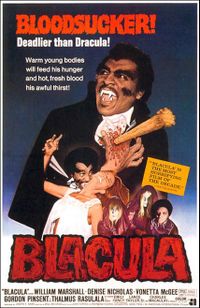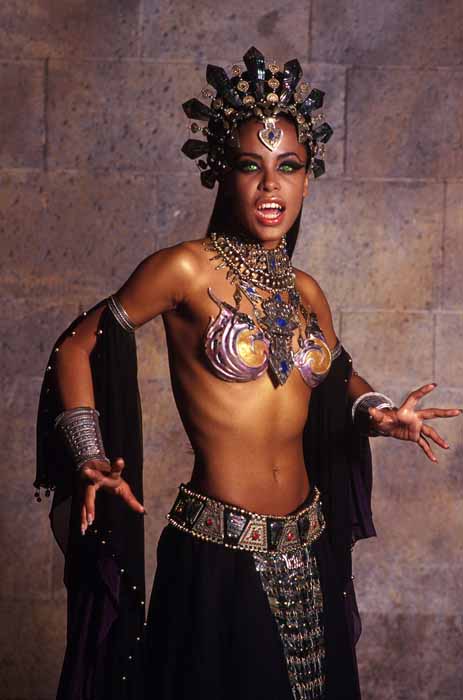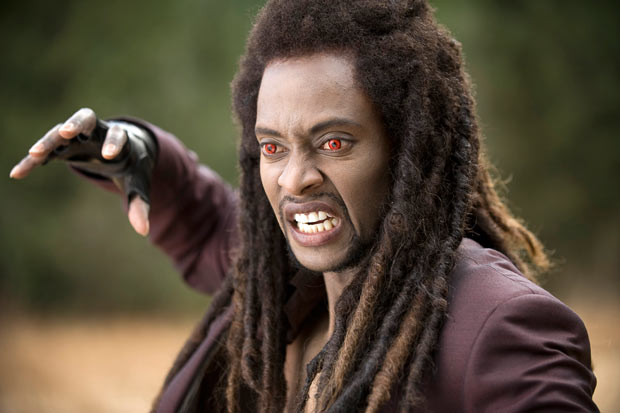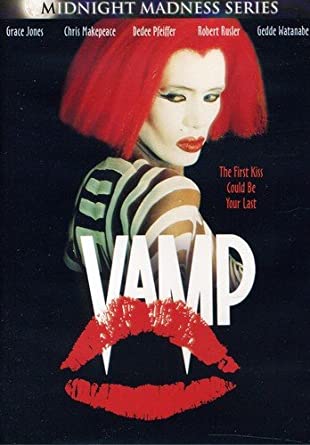As a longtime fan of vampire folklore, literature, and movies, it’s not lost on me that despite the massive quantity of vampire media out there, there’s still much to be desired as far as seeing vampires who look like me (you know, a Black person) in the media. While some may argue that this lack of pigmented vampires is because pale skin is an integral part of vampire folklore, I’m going to call bullshit and challenge that with some quick facts.
Vampire folklore exists on every major continent-yes, including Africa. Tales of bloodsucking phantoms of all cultures, origins, and backgrounds have been around for centuries, so there’s no basis in “reality” for the majority of vampires in Western media to be white. In fact, the first known vampire literature in America is entitled The Black Vampyre: A Legend of St. Domingo, and features both a Black vampire protagonist and an anti-slavery narrative. It was published way back in 1819.

Now let’s fast forward to 1972 when Blacula became one of the first Black vampire horror films. It is also the first film to receive an award for Best Horror Film at the Saturn Awards, and was one of the top-grossing films of the year it was released, despite mixed reviews. Blacula’s success spawned a sequel and sparked a new wave of horror-themed Blaxploitation era films. In it, the titular character is an African prince who seeks the help of none other than Count Dracula, requesting his assistance in helping to end the slave trade. Rather than help, Dracula laughs at the prince and transforms him into a vampire, cursing him with the name “Blacula” and sealing him in a crypt hidden beneath the castle.
In the present day, while there is still an overall lack of Black representation in vampire media, there are some notable exceptions. With this in mind, I want to examine the common themes and qualities of Black vampires in the media I’m familiar with.
The first thing I’ve noticed is that, as in Blacula, their blackness is nearly always a key part of the story. They tend to be described as unique in their respective worlds not only by virtue of being vampires but also because they do not possess deathly pale skin typically associated with their kind. One example of this can be seen in Octavia Butler’s vampire novel, Fledgling. Shori, the protagonist, is the only vampire (or “Ina” as they are called in the novel) who possesses dark skin. Her skin tone is a point of contention for the other vampires, with some viewing her skin as an asset to their entire race, while others feel it will lead to their ruination. Her dark pigmentation is the result of a genetic mutation that allows her to walk around during the day without being harmed by sunlight, unlike her paler counterparts who cannot withstand the tyranny of the sun.

This brings me to another common trope I’ve noticed with Black vampires in media: they tend to be “daywalkers”, meaning the sunlight does not severely impact them. Take Wesley Snipes as the titular character in Blade, for example. In it, Blade is a Black half-vampire who possesses all of the supernatural abilities associated with vampires in his universe, but without the deadly sensitivity to the sunlight. Similarly, Aaliyah’s portrayal of Akasha in the film Queen of the Damned depicts the vampire queen possessing a unique immunity to sunlight, though this power is the result of being the world’s first and oldest vampire as opposed to being the result of her skin tone.
Another common theme I’ve noticed is that Black vampires are often relegated to side roles or villains in their respective stories. Yes, we can argue that all vampires are inherently villainous, but there are far too many sympathetic and even heroic portrayals of vampires for that argument to carry any real weight in certain stories. For instance, the aforementioned Akasha is considered to be “the most monstrous” vampire of all by some of her own kind in the books (rightfully so, as she is determined to deify herself via genocide). Additionally, in the movie, she is hardly featured despite being the titular character.

Laurent in the Twilight movies is also an example of a Black vampire who is a villainous side character. He is also the only Black vampire depicted in the films. He is also an antagonist who attempts to kill the white female protagonist and is subsequently murdered. Interestingly, Laurent is not Black in the books. In fact, none of the vampires are Black in the books, though I do recall that Twilight author Stephanie Meyers made a point to describe a hybrid South American vampire as having “impossibly rich, dark brown skin” in the 3rd novel of the series. This stuck out to me because, in Meyer’s vampire lore, his skin tone was only possible because he was the result of procreation between a human mother and a vampire father; otherwise, he’d simply be pale and white like all of the other vampires. In fact, Meyers also went to the trouble of describing Mexican vampire Maria as having a “slight olive tone” to her pale skin, stating that she had darker skin as a human before becoming a vampire. I’m not even going to get into the issue of literally whitewashing a darker character of color for the sake of keeping all the vampires pale, but I will say that it’s pretty fucking weird that so much emphasis would be placed on it. Meyers’ obsession with maintaining the literal whiteness of her vampire characters also spilled over into the movie casting, so how did we end up with a Black Laurent? It turns out that Catherine Hardewick, who directed the first of the Twilight movies stated that she wanted to diversify the races and skin tones of the vampires for the movies, but Meyer was adamant about all of the vampire characters remaining white, and only compromised in the case Laurent, who again, is a bad guy. Interesting, but I digress.
In addition to Laurent, other relatively recent depictions of Black vampires include Angela Basset’s portrayal of Ramona Royale, a Blaxploitation film star turned vampire in American Horror Story: Hotel, the various Black vampires in Vampire Diaries and True Blood, and an unconventional vampire film from 2016 entitled The Transfiguration. In particular, The Transfiguration stands out as both a non-traditional vampire film and the first vampire film I’ve seen that stars a Black character whose vampirism is not the result of having been transformed, willfully or otherwise, by a white vampire or outside force. he main character is a young, Black teenage boy named Milo who takes his obsession with vampires and blood-drinking to deadly extremes. He is not on a quest to kill other “vampires”, he is actually the main character of the story, and he is more complex and symapthetic (to a degree) as a character than some of the other Black vampires mentioned here. While race and class definitely play a role in the story, they are more implicit than explicit in how they are shown to impact Milo.

Next, I’d like to look at Katrina in the 80s comedy-horror film Vamp. The movie features the iconic Grace Jones as a powerful vampire who uses a strip club as a way to lure in and feed on unsuspecting, horny men. While Vamp is definitely on the sillier end of the spectrum, and is by no means a “good” movie, it is a fun one, and definitely one worth examining here. Unfortunately, Katrina has no spoken lines, and does suffer from the same “side character” syndrome as some of the other Black vampires mentioned. On the other hand, I like the fact that she is basically the queen of the vampires, and her race is not a key factor in the story. She’s otherworldly beautiful, and that’s part of her charm. I could go on forever about how big of a deal it is even now for a dark-skinned Black woman to be depicted as the most beautiful of all in American media, but I’ll save that for another post. There’s never a point where her blackness is a hinderance or even a significant (implicitly or explicitly) factor in the story. In fact, the movie also featured other Black vampires as part of a multi-racial vampire street gang, and race did not play a major role in the story at all. While I do think vampirism can be effectively used to symbolize racism, prejudice, and discrimination in film and literature, it was cool to just see this whacky fantasy world where it wasn’t even an issue at all. The vampires were just vampires, no matter what they looked like. They were all the bad guys (save for one, but I don’t want to spoil it.), so the issue of Black vamps being villains wasn’t as much of an issue as it was for Laurent in the Twilight movies because the representation was not so strikingly disproportionate.
Overall, I would love to see more diversity in horror, especially when it comes to vampires. I find the small selection of Black vampires particularly interesting because vampirism has so often been used as a metaphor for “otherness,” and “not quite humanness” in literature and visual media. Similarly, people of color, especially Black people, have often been subjected to negative “othering” and dehumanization in Western society. I think part of my personal fascination with vampires is that, despite their terrifying appetites, part of me relates to these fictional creatures who are not quite welcome in society and are believed to lack humanity even as their aesthetics and abilities are coveted by the same society that fears them. It’s just something to think about, you know?
~DeLa Doll
PS – If you enjoyed this post, consider subscribing to my mailing list and following me on social media! Thanks for reading!
YouTube. Instagram. FanHouse. Twitter. Shop. Tiktok.
DeLa Doll is a multifaceted artist, writer, and creator with a passion for bold self-expression. With a background in professional writing, nail artistry, and makeup, she brings a unique perspective to beauty, creativity, and storytelling. As the driving force behind DeLa Doll, she blends artistry with authenticity, sharing her journey of entrepreneurship, self-discovery, and growth. Whether crafting luxury press-on nails, exploring media through a critical and creative lens, or documenting her evolving artistic vision, DeLa Doll invites her audience into a world where imagination meets intention.



